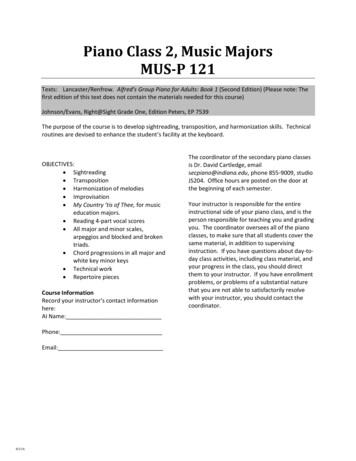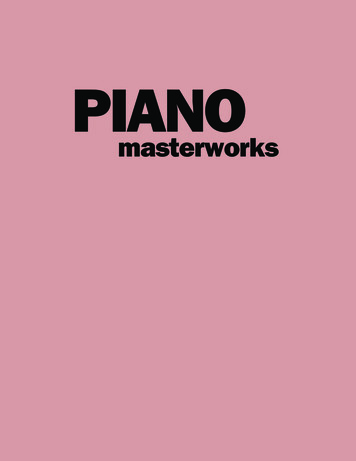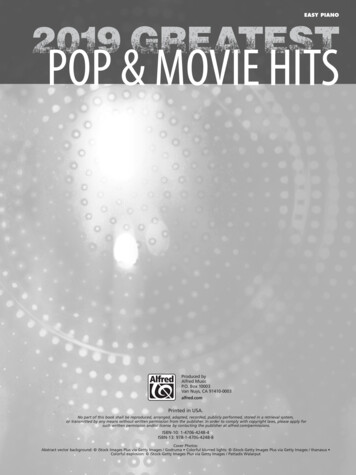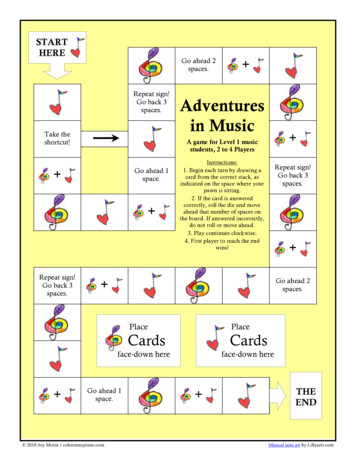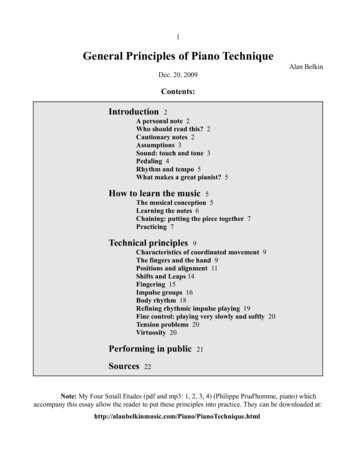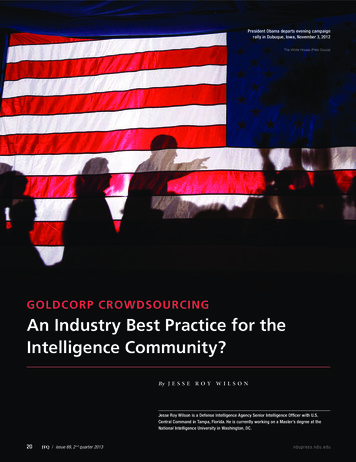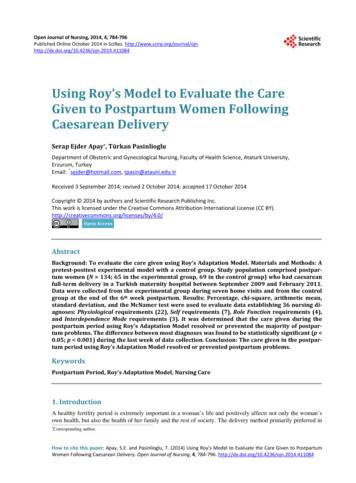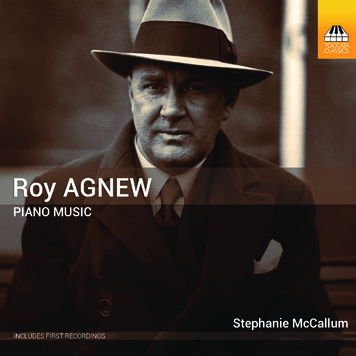
Transcription
ROY AGNEW Piano Music1Rhapsody (1928)* 5:412Toccata (1933)3:24Two Pieces for Piano (1931)*3:113 Whither 1:544 Exaltation 1:17Three Preludes (1927)* 5:105 I2:276 II1:047 III1:398A Dance Impression (1927)*9Drifting Mists (1931) 3:052:1310Sonata (1929) 13:1411Etude (1924)* 2:43Three Poems (1927)*6:5112 I1:5213 II2:0514 III2:5415Sonata Poème (1929, completed 1935)10:56Three Lyrics (1927)*6:0916 The Falling Snow 1:5217 A Quest 2:0318 The Happy Lad 2:142
19Elf Dance: Etude (1928)*2:1320A May Day (1927)*1:37Australian Forest Pieces (1913)*21 No. 1 Gnome Dance22 No. 2 When Evening Shadows Fall23 No. 3 Forest Nymphs at Play24 No. 4 Night in the Forest25 No. 5 By a Quiet Stream26 No. 6 The Forest Grandeur11:131:112:461:191:441:482:25TT 77:42Stephanie McCallum, piano*FIRST RECORDINGS3
THE PIANO MUSIC OF ROY AGNEWby Stephanie McCallumThe piano works of the Australian composer Roy Agnew (1891–1944) are persuasivepieces which show the work of a natural, highly creative pianist, comfortable withhis instrument and able to craft cogent scores in the idioms of his day, including themost modern and controversial styles. They are all headed by dedications, which pointto elements of Sydney musical society in an active period of musical and culturalappreciation, and many retain surviving links of interest to the present. Agnew’s careerdeveloped at a time when Sydney’s musical institutions, the New South Wales StateConservatorium of Music (opened in 1915) and the Sydney Symphony Orchestra,launched in 1936 under the auspices of the new (1932) Australian BroadcastingCommission (ABC), were emerging. There was a thirst for musical culture – newEuropean works, particularly from France, England and Russia, were taken up – but theinfrastructure to support it was uneven. This was the environment in which Agnew’sexceptional, and largely self-generated, creativity was nurtured. His contribution as acomposer, and the degree of international success he achieved, were important to theyoung and developing Australian Federation in the many artistic connections that werestrengthened through his relationships around the world.Agnew was born in Annandale, Sydney, on 23 August 1891, the son of a cordialmanufacturer, taking piano lessons with Daisy Miller and subsequently with SydneyMoss at the newly founded Conservatorium, where he also studied composition withthe Australian composer Alfred Hill. In 1923 he moved to London, where he studiedcomposition and orchestration with Gerard Williams, producing a tone poem TheBreaking of the Drought, which received its first performance in Sydney in 1928with Hill conducting. He was active as a broadcaster in both the UK and Australiain the 1930s and in 1944 was appointed to the staff of the New South Wales State4
Conservatorium. Tragically, however, he died that year, aged only 53, after contractingsepticaemia following tonsillitis.A critical first connection was with the distinguished Odessa-born pianist, BennoMoiseiwitsch, who was married to an Australian violinist, Daisy Kennedy. Moiseiwitschperformed early piano pieces by Agnew in a Sydney Town Hall recital in 1920 andwas instrumental in getting one of those pieces published by Chester in London in1922, the very popular and highly dissonant Dance of the Wild Men.1 The RussianAmerican pianist-composer Leo Ornstein (1893–2002) wrote his Wild Men’s Dance(Danse sauvage) in 1913 and was performing it in concert at least by 1914, its fierceenergy attracting considerable attention in the press. In 1920, Agnew’s friend Georgede Cairos Rego published a review of a book published in 1917 in New York, PianoMastery by Harriette Brower. In the book, Ornstein was interviewed and described hiscluster technique. It therefore seems likely that, whether Agnew had heard Ornstein’spiece or not, he had at least read about its style and content. Like Ornstein’s Wild Men’sDance, Agnew’s Dance of the Wild Men is a young man’s piece, full of exuberance andan enthusiasm for the new; both works earned popularity and a degree of notoriety fortheir composers as figures embracing contemporary international musical ideas.Many fine pianists with European pedigrees by study or background had settled inSydney and carried on discussion and performances of the latest musical trends. The worksin this recording show influences on Agnew’s music that range from Liszt through toDebussy and Bax, but many especially display close affinity with the gestures, textures andharmonic world of Skryabin, a focus of interest in the musical scene of the Sydney of the day.Agnew’s compositions nonetheless remain distinct and individual; in Neville Cardus’ words,he made everything second nature to his essentially lyrical imagination [.]. Roy Agnew didnot make the ultra-modern gesture and declined to be merely ‘fashionable’ and percussive:he was genuinely without pretence and was gentle and modest. His works will outlive, in thequiet intimacy of those who play the piano for music’s sake, vaster and more pretentious stuffs.212Previously recorded on limited-availability CDs by Larry Sitsky and by Tamara Cislowska.Obituary for Agnew, The Sydney Morning Herald, 13 November 1944.5
Rita Crews lists Agnew’s works as including over seventy compositions for piano, sometwenty vocal works, a single chamber work (again with voice) and the tone poem forvoice and orchestra, The Breaking of the Drought.3Agnew’s Rhapsody 1 (1928) was published at the time he returned from his firstvisit to London to tour Australia as a recitalist. The dedication is to Frank Laffitte(1901–82), a distinguished English pianist of French background who knew Bax, Blissand Ireland, among others. He recorded some Duo-Art rolls in the 1920s, performed atthe Proms and taught piano at the Guildhall School.Marked initially ‘With a jolly swinging rhythm’, the Rhapsody has an English modalcolour recalling the music of Bax. The main theme passes through transformations suchas a section marked ‘expressively’ and ‘a little slower’, with the left hand simultaneouslymarked at a lower dynamic ‘in a confused murmur’. To create the confusion, thefundamental bass notes shift the pulse against the melody in an irregular way. After asecond subject, the main theme recapitulates in a quasi fugato contrapuntal setting, witha warm tenor augmentation rounding the texture (Ex. 1).Ex. 1The lyrical, soaring second subject sits on a pedal point. In both exposition andrecapitulation it starts pianissimo and then expands warmly, using the breadth of thepiano range held in the pedal to create fortissimo climaxes (Ex. oy-agnew-australian-heritage-series, accessed 1 July 2019.6
Ex. 2The virtuosic coda breaks away via an accelerating chromatic scale to ‘very fast andwell marked’ thematic octaves, finally broadening and then accelerating throughthree registers to a bold finish. This charming and well-constructed piece, surprisinglynever previously recorded, seems to encapsulate the energy, pianistic suavity and freeinventiveness of early Agnew.In 1938, ten years after the composition of the Rhapsody, Agnew launched a latenight weekly radio programme, ‘Modern and Contemporary Composers’ Session’,where for five years he and a younger-generation Agnew enthusiast, Gordon Watson(1921–99), presented modern piano works live to air; the composers representedranged from the Second Viennese School through Busoni, Debussy, Milhaud, Skryabin,Stravinsky and Szymanowski.4Agnew had married in Sydney in 1930 before returning to London for a fewyears with his new bride, and there he wrote many of his piano pieces, includingthe Toccata 2 (1933). Dedicated ‘to my Wife’, it was published before their finalreturn to Sydney in 1934. Unlike the other pieces from this period, which wereall published by Augener in London, the Toccata was published by Chester, alsoMy copy of the Rhapsody was passed down from my Sydney teacher, Gordon Watson. It was clearly previously owned by WilfredArlom, whose signature appears on the cover. He was one of a group of fearless pianists, including Winifred Burston and HenriPenn, who performed Debussy, Skryabin and other modern composers in the 1920s and beyond in Sydney. My previous teacher,Alexander Sverjensky, gave the first performance of Agnew’s last major work, Sonata Legend, in 1944, published in 1949 asCapricornia (Sonata Legend).47
in London, in ‘The Chesterian’ series of Graded Piano Music edited by Thomas F.Dunhill. It weighed in at Grade VII (Advanced), along with works by Goossens,Medtner, Palmgren, Poulenc, Skryabin, Swinstead and others. This association withgraded examination music was later followed up with works set by the Australian MusicExaminations Board (AMEB), for which Agnew, in his final years, also acted as anexaminer.The main motif of the Toccata involves a theme in thirds above which writheperpetuum mobile semiquavers moving often in a tremolando figuration and rangingwidely across registers and key centres. Cross-rhythms in the bass add complexity(Ex. 3) as, later, do double notes with added melodic material.Ex. 3Fluid lines build to cascading double notes in fourths, with a ‘slow and expressive’questioning section interrupted by a wave of notes marked ‘As fast as possible’, beforea reharmonised recapitulation of the opening material. The final climactic sweep isfinished with a gentle swirl of notes over bass harmonics (Ex. 4).‘Whither’ 3 and ‘Exaltation’ 4 (1931) were published as a contrasted pair ofminiatures, Two Pieces for Piano. Their virtuosity indicates the pianistic powers of theirdedicatee, Rex de Cairos Rego. Rex and his sister Iris were both pianists and composersin Sydney. Their father, George, was founding Secretary of the Musical Association ofNSW (1912–34) during the period when Agnew built his early reputation as a composer.‘Whither’, marked ‘Expressively’ and rubato, gently floats between B flat minor and8
Ex. 4a disarming G flat major and acts as a foil for the short burst of the following piece,‘Exaltation’, to be played ‘With passion and intensity’. Highly charged and skiddingaround the black keys of E flat minor, tempo fluctuations are inserted frequentlythroughout, encouraging a freely expressive approach.Agnew’s Three Preludes (1927) are among at least seven he wrote for piano. Thesethree miniatures sound like a homage to Skryabin’s Op. 11 Preludes, harmonicallycomplex but with clear tonal centres. They are dedicated to Miss Gertrude Barton,a musical Sydney school principal who had helped organise donations to supportAgnew’s initial travel to London in 1923. Prelude I 5 , ‘With simple tenderness’, tracescontrapuntal lines, bound by held notes in the line to create harmonic warmth. Thoughchromatically inflected, it is in a simple A major. Prelude II 6 , ‘Intensely (with anelastic rhythm)’, creates brooding darkness with a pulsating texture in E flat minor.Characteristic rubati are marked throughout. Prelude III 7 , ‘Expressively’, like PreludeI, is also marked rubato. Ruminative and lyrical, this piece slides chromatically withoutreally settling on its tonic chord of B major until the very end.A Dance Impression 8 (1927) introduces popular music elements with swingrhythms, bass-drum beats and ragtime. The opening descent juxtaposes chords ofD and E flat major. Complex jazz-style harmonies later settle down in the middle section9
to a fairly stable G major. Parallel chords and transpositions disrupt the sense of keyelsewhere (Ex. 5), but the ending repeats the opening idea with D major now firmly incontrol. From the same year as the Three Preludes, this piece is similarly dedicated to aSydney personality, Henri Penn, a fine piano soloist who also acted as the accompanistfor visiting soloists for the ABC up until the 1960s.Ex. 5Drifting Mists 9 (1931) is marked ‘Dim and shadowy’, the texture at the openingthreading wispy, curving semiquavers between a sombre theme and striding octave bass.The middle section builds gradually to a sweeping climax with both hands leaping tomaintain the full pedal-held sound (Ex. 6). The sound dissipates quickly before the returnof the main theme, extinguishing itself in a characteristic Agnew gesture of a fading swirlof very fast notes. The marking ‘gradually more vague and shadowy to the end’ couldequally apply to the next work, which embodies a similar subterranean gloom at the close.Shadforth Hooper, the dedicatee, was a well-established pianist who had returned toSydney in 1907 after three years in Europe, where she had studied with Michael Hambourgin London and Teresa Carreño in Berlin. She later taught early piano, harmony and theoryto the distinguished Australian composer Nigel Butterley (b. 1935).5Agnew’s Sonata (1929) 10 immediately strikes the listener who is familiar withSkryabin’s Piano Sonata No. 9 (1913) as working in the same tonal world and withsimilar motif shapes, length and structure. The lively discussion and performance ofSkryabin’s sonatas in Sydney in the early 1920s make Agnew’s acquaintance with thisIn another historical link, I gave the London premiere of Nigel Butterley’s Uttering Joyous Leaves (1981). It is also recorded on myalbum Notations (Tall Poppies tp037, 1994).510
Ex. 6work certain, and Larry Sitsky surmises6 that the close relationship of the two workscould be a reason that it remained unpublished at Agnew’s death. For this recording atypeset edition taken from a facsimile of the composer’s manuscript and published bythe Australian Music Centre in 1999 was used. This typeset copy clearly has some errors,and there will always be questions about some pitches, but any repetitions which areslightly varied, and which still make sense, have been left in place, as there are so manyinstances in Agnew of slight variations and reharmonisations as part of his style.7 Aswith all his piano music, counterpoint is an essential aspect of the fabric. The embeddingof the main motif (Ex.
The piano works of the Australian composer Roy Agnew (1891–1944) are persuasive pieces which show the work of a natural, highly creative pianist, comfortable with his instrument and able to craft cogent scores in the idioms of his day, including the most modern and controversial styles. They are all headed by dedications, which point to elements of Sydney musical society in an active period .
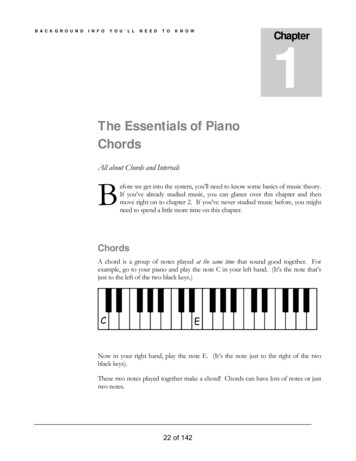
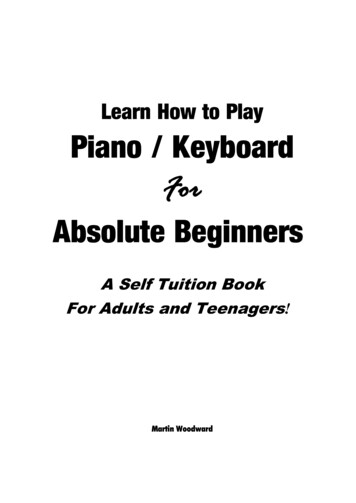

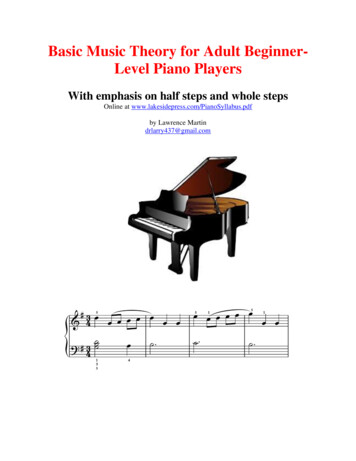
![Roman Statkowski [1859-1925] Piano Music](/img/3/25129booklet.jpg)
